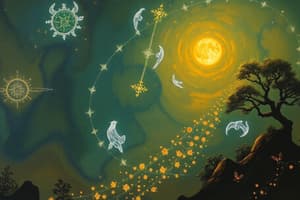Podcast
Questions and Answers
Explain the concept of supernatural aid in the hero's journey according to Campbell's theory.
Explain the concept of supernatural aid in the hero's journey according to Campbell's theory.
The concept of supernatural aid in the hero's journey refers to the appearance of a guide or magical helper once the hero has committed to the quest. This figure represents a benign, protecting power of destiny and often presents the hero with talismans or artifacts that aid them in their quest.
What is the significance of the crossing of the first threshold in the hero's journey?
What is the significance of the crossing of the first threshold in the hero's journey?
The crossing of the first threshold marks the point where the hero leaves the known limits of their world and ventures into an unknown and dangerous realm. It symbolizes a passage beyond the veil of the known into the unknown, where the rules and limits are unknown.
How does Campbell describe the role of the 'threshold guardian' in the hero's adventure?
How does Campbell describe the role of the 'threshold guardian' in the hero's adventure?
Campbell describes the 'threshold guardian' as the personification of the hero's destiny who guides and aids the hero in their adventure until they come to the entrance of the zone of magnified power. These custodians represent the limits of the hero's present sphere or life horizon, and beyond them lies darkness, the unknown, and danger.
What does the hero's act coinciding with the society's readiness symbolize in Campbell's theory?
What does the hero's act coinciding with the society's readiness symbolize in Campbell's theory?
According to Campbell, what does the hero find as they continue to follow courageously as the consequences unfold?
According to Campbell, what does the hero find as they continue to follow courageously as the consequences unfold?
How does Campbell characterize the adventure in the hero's journey?
How does Campbell characterize the adventure in the hero's journey?
What does the appearance of the supernatural mentor represent in the hero's journey?
What does the appearance of the supernatural mentor represent in the hero's journey?
What is the role of talismans or artifacts in the hero's journey, according to Campbell?
What is the role of talismans or artifacts in the hero's journey, according to Campbell?
According to Campbell, what is the function of the supernatural mentor in the hero's journey?
According to Campbell, what is the function of the supernatural mentor in the hero's journey?
How does Campbell describe the role of the 'threshold guardian' in the hero's adventure?
How does Campbell describe the role of the 'threshold guardian' in the hero's adventure?
Explain the significance of the hero crossing into the field of adventure, according to Campbell's theory.
Explain the significance of the hero crossing into the field of adventure, according to Campbell's theory.
What does Campbell suggest about the hero's act coinciding with that for which their society is ready?
What does Campbell suggest about the hero's act coinciding with that for which their society is ready?
According to Campbell, what do the ageless guardians symbolize in the hero's journey?
According to Campbell, what do the ageless guardians symbolize in the hero's journey?
Who proposed narrative patterns in hero myths in terms of Freudian psychoanalysis and ritualism?
Who proposed narrative patterns in hero myths in terms of Freudian psychoanalysis and ritualism?
What term did Campbell borrow from James Joyce's Finnegans Wake?
What term did Campbell borrow from James Joyce's Finnegans Wake?
According to Campbell, what region does the Call to Adventure represent?
According to Campbell, what region does the Call to Adventure represent?
What may the hero do to accomplish the adventure, according to Campbell?
What may the hero do to accomplish the adventure, according to Campbell?
What is the first stage of the monomyth's Departure section?
What is the first stage of the monomyth's Departure section?
What happens when the future hero first refuses to heed the call?
What happens when the future hero first refuses to heed the call?
In what book did Campbell summarize the narrative pattern of the monomyth?
In what book did Campbell summarize the narrative pattern of the monomyth?
How many stages does Campbell describe in the monomyth?
How many stages does Campbell describe in the monomyth?
Who referred to Vyacheslav Ivanov's treatment of Dionysus as 'Ivanov's monomyth'?
Who referred to Vyacheslav Ivanov's treatment of Dionysus as 'Ivanov's monomyth'?
What may be organized in a number of ways, including division into three 'acts' or sections?
What may be organized in a number of ways, including division into three 'acts' or sections?
In the return section, what must the hero do with his reward?
In the return section, what must the hero do with his reward?
According to Campbell, what happens to the hero himself after the adventure?
According to Campbell, what happens to the hero himself after the adventure?
What are some criticisms of Joseph Campbell's concept of the 'monomyth'?
What are some criticisms of Joseph Campbell's concept of the 'monomyth'?
Who were some of the earlier figures that proposed similar concepts to the hero's journey or monomyth?
Who were some of the earlier figures that proposed similar concepts to the hero's journey or monomyth?
What is the significance of the hero's journey being analyzed as an example of the sympathetic plot?
What is the significance of the hero's journey being analyzed as an example of the sympathetic plot?
Who popularized the hero myth pattern studies and how did he influence the concept?
Who popularized the hero myth pattern studies and how did he influence the concept?
According to Joseph Campbell, how many stages are organized into the hero's journey?
According to Joseph Campbell, how many stages are organized into the hero's journey?
What term did Joseph Campbell borrow to imply the ultimate narrative archetype?
What term did Joseph Campbell borrow to imply the ultimate narrative archetype?
In Joseph Campbell's theory, what may the hero receive in the departure section and how does the hero initially respond to it?
In Joseph Campbell's theory, what may the hero receive in the departure section and how does the hero initially respond to it?
How does Campbell summarize the monomyth narrative pattern in his book 'The Hero with a Thousand Faces' (1949)?
How does Campbell summarize the monomyth narrative pattern in his book 'The Hero with a Thousand Faces' (1949)?
According to Campbell, what are the three acts into which the 17 stages of the monomyth are organized?
According to Campbell, what are the three acts into which the 17 stages of the monomyth are organized?
In the departure section of the hero's journey, what are the two key stages described by Campbell?
In the departure section of the hero's journey, what are the two key stages described by Campbell?
What does the initiation section of the hero's journey involve according to Joseph Campbell?
What does the initiation section of the hero's journey involve according to Joseph Campbell?
What three parts are the 17 stages of the monomyth organized into according to Joseph Campbell?
What three parts are the 17 stages of the monomyth organized into according to Joseph Campbell?
What may the refusal of the call be due to according to Campbell's theory?
What may the refusal of the call be due to according to Campbell's theory?
What does the return section of the hero's journey see the hero doing with the gained treasure or elixir?
What does the return section of the hero's journey see the hero doing with the gained treasure or elixir?
What are the three acts into which the 17 stages of the monomyth may be organized according to Campbell?
What are the three acts into which the 17 stages of the monomyth may be organized according to Campbell?
Flashcards
Supernatural Aid
Supernatural Aid
A guide or magical helper appears after the hero commits to the quest. This figure represents a benign, protecting power and provides talismans.
Crossing of the First Threshold
Crossing of the First Threshold
The hero leaves their known world and enters an unknown, dangerous realm, symbolizing a venture into the unknown with unfamiliar rules.
Threshold Guardian
Threshold Guardian
The 'threshold guardian' personifies the limits of the hero's current life, guarding the entrance to a zone of magnified power. These custodians guide and aid the hero until the entrance of the zone of magnified power.
Society's Readiness
Society's Readiness
Signup and view all the flashcards
Forces of the Unconscious
Forces of the Unconscious
Signup and view all the flashcards
The Adventure
The Adventure
Signup and view all the flashcards
Supernatural Mentor
Supernatural Mentor
Signup and view all the flashcards
Talismans or Artifacts
Talismans or Artifacts
Signup and view all the flashcards
Function of Mentor
Function of Mentor
Signup and view all the flashcards
Role of Threshold Guardian
Role of Threshold Guardian
Signup and view all the flashcards
Crossing into Adventure
Crossing into Adventure
Signup and view all the flashcards
Hero's Act Coinciding
Hero's Act Coinciding
Signup and view all the flashcards
Ageless Guardians
Ageless Guardians
Signup and view all the flashcards
Otto Rank and Lord Raglan
Otto Rank and Lord Raglan
Signup and view all the flashcards
Monomyth
Monomyth
Signup and view all the flashcards
Call to Adventure Region
Call to Adventure Region
Signup and view all the flashcards
Hero's Accomplishment
Hero's Accomplishment
Signup and view all the flashcards
First Stage of Departure
First Stage of Departure
Signup and view all the flashcards
Refusal Consequences
Refusal Consequences
Signup and view all the flashcards
'The Hero with a Thousand Faces'
'The Hero with a Thousand Faces'
Signup and view all the flashcards
Stages in the Monomyth
Stages in the Monomyth
Signup and view all the flashcards
Omry Ronen
Omry Ronen
Signup and view all the flashcards
Organization of Stages
Organization of Stages
Signup and view all the flashcards
Must Do With Reward
Must Do With Reward
Signup and view all the flashcards
Transformation After Adventure
Transformation After Adventure
Signup and view all the flashcards
Campbell's Criticism
Campbell's Criticism
Signup and view all the flashcards
Earlier Proponents
Earlier Proponents
Signup and view all the flashcards
Sympathetic Plot
Sympathetic Plot
Signup and view all the flashcards
Campbell's Influence
Campbell's Influence
Signup and view all the flashcards
Journey's Organization
Journey's Organization
Signup and view all the flashcards
Study Notes
The Hero's Journey: Joseph Campbell's Monomyth
- Hero myth narratives were studied as early as 1871 by anthropologist Edward Burnett Tylor, and later by psychoanalyst Otto Rank and anthropologist Lord Raglan.
- The term "monomyth" was borrowed by Campbell from James Joyce's Finnegans Wake and implies the ultimate narrative archetype.
- "The Hero's Journey" entered popular discourse through documentaries and interviews with Campbell.
- Campbell's book "The Hero with a Thousand Faces" (1949) summarizes the monomyth narrative pattern as a hero venturing into a region of supernatural wonder, encountering forces, and returning with the power to bestow boons.
- Campbell describes 17 stages of the monomyth, not all of which are necessarily present in all myths.
- The 17 stages may be organized into three acts: departure, initiation, and return.
- In the departure part, the hero receives a call to adventure and may be helped by a mentor figure.
- The initiation section involves the hero traversing into a special world, facing tasks or trials, and eventually undergoing "apotheosis" and gaining a reward.
- The return section sees the hero returning to the ordinary world with the gained treasure or elixir, transforming and gaining wisdom.
- Campbell's seventeen stages are organized into three parts: departure, initiation, and return.
- The departure section includes the "Call to Adventure," representing a distant or unknown place, and the "Refusal of the Call," where the hero initially refuses to heed the call.
- The refusal of the call may be due to fear, insecurity, or a sense of inadequacy, which converts the adventure into its negative.
Studying That Suits You
Use AI to generate personalized quizzes and flashcards to suit your learning preferences.




